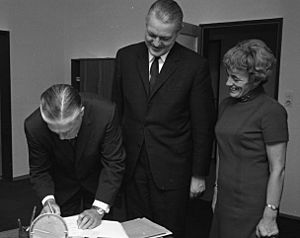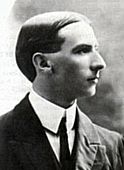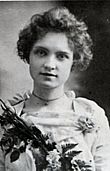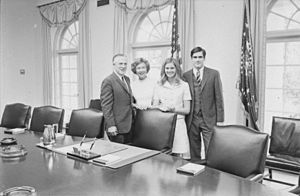Lenore Romney facts for kids
Quick facts for kids
Lenore Romney
|
|
|---|---|

Romney in a Senate campaign ad c. 1970
|
|
| First Lady of Michigan | |
| In role January 1, 1963 – January 22, 1969 |
|
| Governor | George Romney |
| Preceded by | Alice Swainson |
| Succeeded by | Helen Milliken |
| Personal details | |
| Born |
Lenore Lafount
November 9, 1908 Logan, Utah, U.S. |
| Died | July 7, 1998 (aged 89) Royal Oak, Michigan, U.S. |
| Political party | Republican |
| Spouse | |
| Children | 4, including Mitt and Scott |
| Parent |
|
| Relatives | Romney family |
| Education | |
Lenore LaFount Romney (born November 9, 1908 – died July 7, 1998) was an American actress and political figure. She was the wife of businessman and politician George W. Romney. Lenore served as the First Lady of Michigan from 1963 to 1969. She was also the Republican Party candidate for the U.S. Senate in 1970 from Michigan. Her younger son, Mitt Romney, is a U.S. Senator from Utah. He was also a former Governor of Massachusetts and ran for president in 2012.
Lenore LaFount was born in Logan, Utah. She grew up in Salt Lake City. She attended Latter-day Saints High School. There, she became interested in acting and met George Romney. She went to the University of Utah and George Washington University. She graduated in 1929. Lenore studied acting in New York. Then, she moved to Hollywood. She appeared in several films with Metro-Goldwyn-Mayer. She turned down a movie contract and married George Romney in 1931. They had four children. Lenore was a stay-at-home mother. The family lived in Bloomfield Hills, Michigan.
Lenore Romney was a popular First Lady of Michigan. She often spoke at events and to community groups. She was involved in many charities and cultural organizations. These included the Muscular Dystrophy Association and the YWCA. She was also active in the Church of Jesus Christ of Latter-day Saints. She was a lifelong member. She helped her husband during his 1968 presidential campaign. Lenore believed in traditional values. However, she also supported women having bigger roles in business and politics.
In 1970, her husband and state Republican leaders encouraged her to run for the U.S. Senate. She ran against Senator Philip Hart. But she found it hard to be seen as a serious candidate on her own. She also struggled to get support from some conservatives in her party. She barely won the primary election against Robert J. Huber. She lost the general election to Hart by a large margin. After the election, she returned to volunteer work. She gave speeches to various groups.
Contents
Early Life and Education
(1880–1952)
(1882–1938)
Lenore LaFount was born on November 9, 1908. She was born in Logan, Utah. She was the second of four daughters. Her parents were Alma Luella (Robison) and Harold Arundel Lafount. Her father was from England. Her mother was from Idaho. The family belonged to the Church of Jesus Christ of Latter-day Saints. Her father had joined the church in England. Her mother's grandmother was a Mormon pioneer. Lenore's father made headphones. Her mother was active in local charities.
Lenore grew up in Salt Lake City. She played the ukulele. She was part of a girls' club called The Seagulls. She went to Latter-day Saints High School. She loved drama there. In 1924, she met George W. Romney. They became high school sweethearts. Lenore's family was more established than George's. But George pursued her strongly.
She finished high school in 1926. She went to the University of Utah for two years. George went to England as a Mormon missionary. She promised him she wouldn't kiss anyone while he was away. In 1927, she was chosen to welcome Charles Lindbergh to Salt Lake City. She was featured on the front page of the Salt Lake Telegram. Later that year, her father was appointed to the Federal Radio Commission. Her family moved to Washington, D.C. Lenore transferred to George Washington University. She graduated in June 1929 with a degree in English literature. George soon followed her to Washington.
Acting Career
Lenore's mother wanted her to try acting before getting married. Lenore moved to New York. She studied acting at the American Laboratory Theatre. She learned the Stanislavski's system. She found it very inspiring. She acted in plays by Shakespeare, Ibsen, and Chekhov. She won an award in 1930. Talent scouts noticed her. She received offers from NBC and Metro-Goldwyn-Mayer (MGM). She chose MGM, even though George didn't want her to. George then moved to Los Angeles to be with her. They got engaged in September 1930.
Lenore was a tall, slender woman with chestnut hair. She got small roles in Hollywood films. She appeared in a Greta Garbo film. She was also in A Tailor Made Man with William Haines. She worked with Jean Harlow and Ramon Navarro. She was a stand-in for Lili Damita. Her trained voice was useful for talking pictures. She did voice work for cartoons, playing speaking cats and dogs. George was very jealous of her meeting stars like Clark Gable. She even threatened to break off their engagement.
After a few months, MGM offered her a three-year contract. It was worth a lot of money. But she didn't like some parts of Hollywood. She disliked being asked to pose for "cheesecake photos." She also found the long waits between shots boring. She read novels on set to pass the time. George finally convinced her to marry him. They moved back to Washington, where he worked as a lobbyist.
Lenore later said she never regretted giving up movies. She felt she couldn't have both a marriage and an acting career. She said, "It was never either and; it was always either or." George later called winning her over his greatest sales success.
Marriage and Family Life
Lenore LaFount married George Romney on July 2, 1931. Their wedding was at the Salt Lake Temple. About 400 guests attended their reception.
In Washington, Lenore's social skills helped George's career. They met important people like the Hoovers and Roosevelts. George often asked her to host parties on short notice. From 1933 to 1934, Lenore hosted a weekly radio show. It was called Poetical Hitchhiking. She read poems on the show. She also directed student plays at George Washington University.
Their first child, Lynn, was born in 1935. Lenore became a stay-at-home mother. Their second daughter, Jane, was born in 1938. In 1939, the family moved to Detroit, Michigan. George got a job with the Automobile Manufacturers Association. Their first son, Scott, was born in 1941. Lenore wanted another child, but doctors said it might be dangerous. In 1946, they started to adopt a child. But Lenore became pregnant. After a difficult pregnancy and birth, Willard Mitt was born in 1947. Lenore called Mitt her "miracle baby."
The family moved to Bloomfield Hills, Michigan, around 1953. In 1953, Lenore had another health scare. A wrong blood transfusion put her life in danger. But she recovered. In 1954, George became president of American Motors Corporation. Lenore suffered from bursitis. This left her left arm unable to move for five years. The family helped with chores. They spent summers at a cottage in Canada.
George was very devoted to Lenore. He tried to bring her a flower every day. He often left a single rose with a love note. George was a strong person. But Lenore was calm and stood up to him. They often argued, so much that their grandchildren called them "the Bickersons." But they always settled their arguments. Lenore still wanted more for herself. Mitt later said she always seemed to want "something a little more."
First Lady of Michigan
In 1962, George Romney decided to run for Governor of Michigan. Lenore and their family supported him. She said, "We're all dedicated with him for better government." She played an important role in the campaign. She gave speeches to Republican women's groups. This was unusual for women at the time. She campaigned in rural areas. George focused on the Detroit area.
George won the election in November 1962. Lenore became Michigan's First Lady. She said her goal was to improve "human relations." She wanted to bring people together. She said women had an important role in this. She didn't want to just be a "society leader."

She was a popular First Lady. She often spoke at events and to community groups. She was known for speaking well. She helped her husband's political career. Like George, she did not make public appearances on Sundays. George was re-elected in 1964 and 1966. She often campaigned with him. She was more active in her party than other Michigan first ladies. She knew his policy ideas very well. She went with him on almost all his trips. She even gave his speeches if he couldn't attend. Some people thought she was smarter than him.
Lenore supported women getting involved in business and politics. By 1966, she asked audiences, "Why should women have any less say than men?" She said women had a lot to offer in public service.
She spoke out against the counterculture phrase "Turn on, tune in, drop out". She asked, "What kind of a philosophy is that?" She told young people to "Think of something outside of yourselves." She said, "You have the right to rebel, but make sure what you're rebelling for is greater than what you're rebelling against."
She was a very religious member of The Church of Jesus Christ of Latter-day Saints. She taught Sunday School for many years. Her views on some social issues were more open than many Republicans. She appeared with Martin Luther King Jr. in 1966. She defended her church's policy on black people. She said, "If my church taught me anything other than that the Negro is equal to any other person, I could not accept it." In 1967, she said she would leave the Detroit Women's City Club. This was because it had a policy against black guests eating in its dining room.
During her husband's 1968 presidential campaign, Lenore helped him stay calm. She was good at campaigning. She seemed comfortable and spoke well without notes. The Associated Press called her "the most indefatigable campaigner." The New York Times said she was a very effective speaker. They thought she might even win votes for her husband. George later dropped out of the race in February 1968.
Lenore continued to have health problems. She visited many medical centers. Doctors thought her problems were due to not absorbing enough calcium. She also had several food allergies. She was hospitalized in 1967 and 1968 for injuries and other issues.
Lenore Romney worked for many volunteer groups. In 1963, she co-chaired the Muscular Dystrophy Association. By 1970, she was on the national board of the YWCA. She was also on the advisory board for American Field Services. She held high positions with Goodwill Industries and other groups. She worked with Project HOPE. She was chair of the Detroit Grand Opera Association. She was active with the Detroit Symphony Orchestra. The Boston Globe called her a "pillar of Detroit society."
1970 U.S. Senate Campaign
After the 1968 presidential election, George Romney became the U.S. Secretary of Housing and Urban Development. Lenore was not excited to move back to Washington. But she said a wife wants to be with her husband. By then, they had 12 grandchildren.
For the 1970 U.S. Senate election in Michigan, Republicans needed someone to run. They wanted to run against Democrat Philip Hart. Hart was expected to win easily. But Republicans thought he might be weak because he was seen as too liberal. George Romney's name was mentioned as a possible candidate. President Nixon wanted George out of his administration. He thought of a plan to get George to run for the Senate. But George suggested Lenore run instead. Lenore's name started to be mentioned. She said she wouldn't run unless no one else could be found.
The state Republican Party had a system. Leaders would meet to choose a "consensus" candidate. At a meeting in February 1970, Lenore faced opposition. She couldn't get enough votes to be the consensus candidate. On February 23, she officially entered the race. George pressured Governor William Milliken to support her. This caused some bad publicity. At the next party meeting, she won 92 percent of the leaders' votes. This made her the consensus candidate.
Lenore's campaign focused on her being a woman. Her theme was, "Never before has the voice and understanding of a concerned woman been more needed." Billboards showed her face with just "Lenore." She was still photogenic. But she was very thin. Her husband sometimes worried about her weight. She made a campaign film. It featured endorsements from leaders and celebrities. It showed her family role and concern for people. Her opponent, Robert Huber, focused on his political experience. He criticized the idea of another Romney in office.
On the Vietnam War, Romney called for all U.S. troops to leave by the end of 1971. She called the war "disastrous." She was worried about the Cambodian Incursion. She said she would vote to cut off funds if Nixon didn't withdraw. On other issues, her stances were sometimes unclear. The conservative part of her party didn't trust her. The male reporters often treated her like a child. She was often called "Mrs. George Romney." Her campaign struggled to gain momentum. Polls showed a close race. She then focused her ads on her policy positions. In the August 4, 1970, primary, Lenore Romney won by a small margin. She got 52 percent of the vote. Huber got 48 percent.
In the general election, Romney was behind Hart from the start. Her party was divided. Her campaign had spent a lot of money in the primary. Romney issued policy papers. She talked about crime and social issues. She also supported a national healthcare plan. She wanted more attention to environmental damage. She never attacked Hart personally. She was the only woman running for the U.S. Senate that year. She campaigned tirelessly. She traveled around the state and made many stops a day. But people still felt she didn't have a clear vision. They thought she was only running because she was George Romney's wife. She said, "I'm not a stand-in or a substitute for anyone." Her campaign materials still just said "Lenore." Her husband's efforts to enforce housing integration also hurt her campaign. Hart ran a quiet campaign. He mostly ignored her.
The Romney children campaigned for her. Mitt took time off from school to help. He worked as a driver and advance man. Lenore and Mitt visited all 83 Michigan counties. George was mostly in Washington. He didn't campaign for her until the last day.
On November 3, 1970, Hart won a third term. He got 67 percent of the vote. Lenore got 33 percent. Romney made an unusual visit to congratulate Hart in person. She gave a very gracious concession speech.
The campaign and loss caused Lenore emotional pain. She said, "I thought [running as a woman] would be an asset. It was disappointing to find that many people closed their minds just because I was a woman." She wrote about this in Look magazine. She described how men and women dismissed her. She wrote, "In factories, I encountered men... shouting, 'Get in the kitchen. George needs you there.'" She told a friend that she wished she hadn't run. She felt it was "the most humiliating thing I know of."
Later Years
After the campaign, Lenore Romney returned to Washington. She continued her role as a cabinet wife. George helped start the National Center for Voluntary Action in 1970. Lenore became a member of its executive committee. By late 1971, she took on some of First Lady Pat Nixon's role. She promoted volunteerism. She visited volunteer centers with other cabinet wives. She was on the board of the National Conference of Christians and Jews. She also helped with the Urban Service Corps. This group used volunteers to help big cities. She worked with the National Women's Political Caucus. She gave speeches at colleges.
In the 1972 U.S. presidential election, Lenore Romney worked for Nixon's re-election campaign. However, her husband's relationship with Nixon worsened. In August 1972, she wrote a letter to a presidential aide. She urged better treatment for George.
George Romney left politics in January 1973. Lenore continued her volunteer work. She was vice president of the National Center for Voluntary Action. In 1974, she became a commentator on the WJR radio show Point of View. She then stepped back from public political life. But she remained active. She gave speeches to local religious and civic groups. She focused on her faith, "people power," and the role of women.
At age 85, Lenore Romney gave interviews. This was during her son Mitt's 1994 campaign for the U.S. Senate. She compared Mitt to his opponent, Senator Ted Kennedy. Mitt lost the race.
On July 26, 1995, George Romney died at age 88. He had a heart attack while exercising. Lenore found him. They had been married for 64 years. The press noted their strong marriage.
Lenore's health declined in her final years. At age 89, she had a stroke. She died several days later on July 7, 1998. She was survived by her four children, 24 grandchildren, and 41 great-grandchildren. She is buried in Fairview Cemetery in Brighton, Michigan.
Many state political figures honored her after her death. Governor John Engler called her "Michigan's rose." Lieutenant Governor Connie Binsfeld called her a "beloved role model."
Awards and Honors
In 1969, Lenore Romney received the Woman of the Year Award. This was from Brigham Young University. She was named one of the National Top Ten Women News Makers for 1970. She received the Salvation Army's Humanitarian Award. She also got Michigan State University's Distinguished Citizen Award. She was recognized by Hadassah and the International Platform Association.
Since 1987, organizations like the Points of Light Foundation have given an annual award. It is called the George and Lenore Romney Citizen Volunteer Award.
Lenore Romney received six honorary degrees. She received an L.H.D. from Hillsdale College in 1964. She also received one from Hope College in 1967. And another from Gwynedd–Mercy College in 1971. She received an LL.D. from Central Michigan University in 1966. She received a Doctor of Humanities degree from Eastern Michigan University in 1968. And another from Detroit College of Business in 1970.





